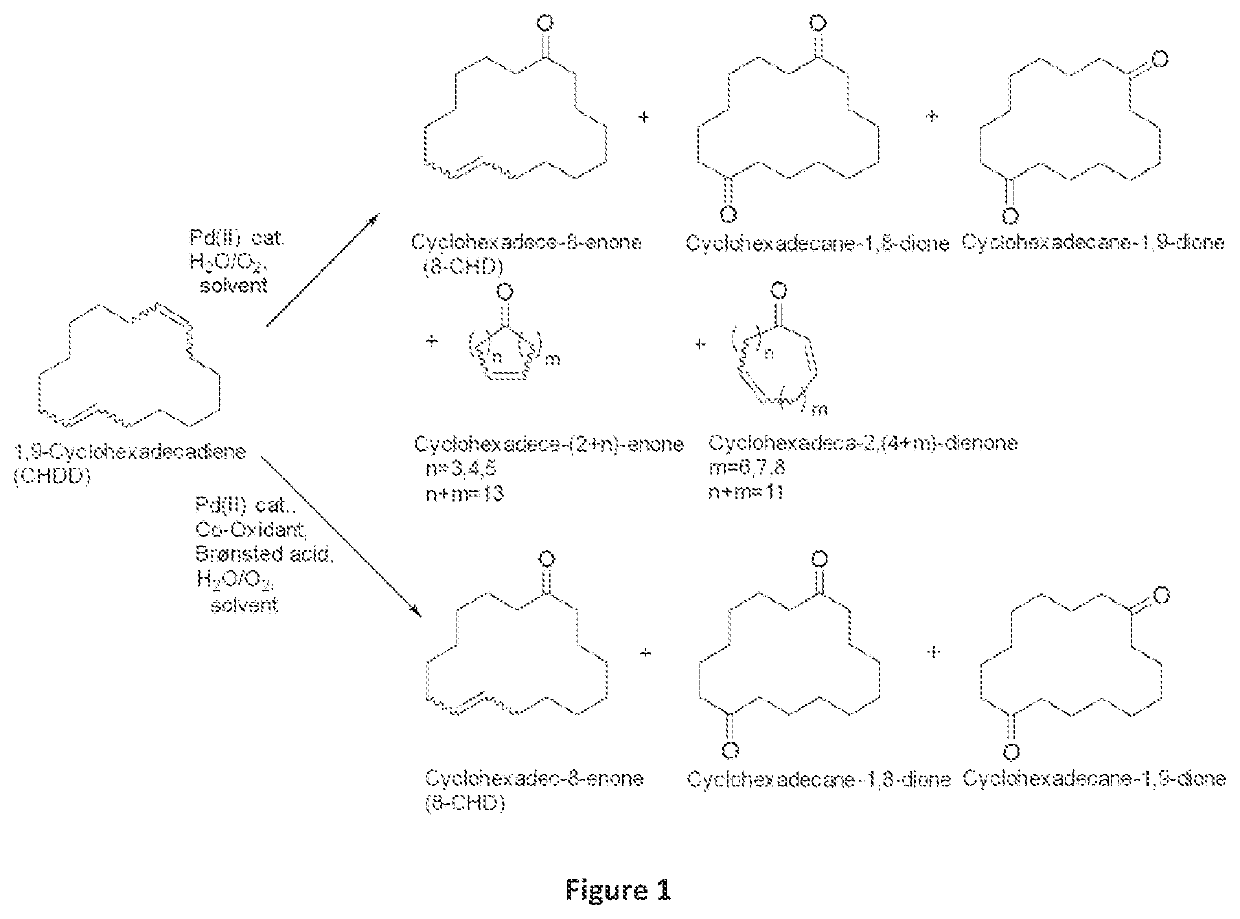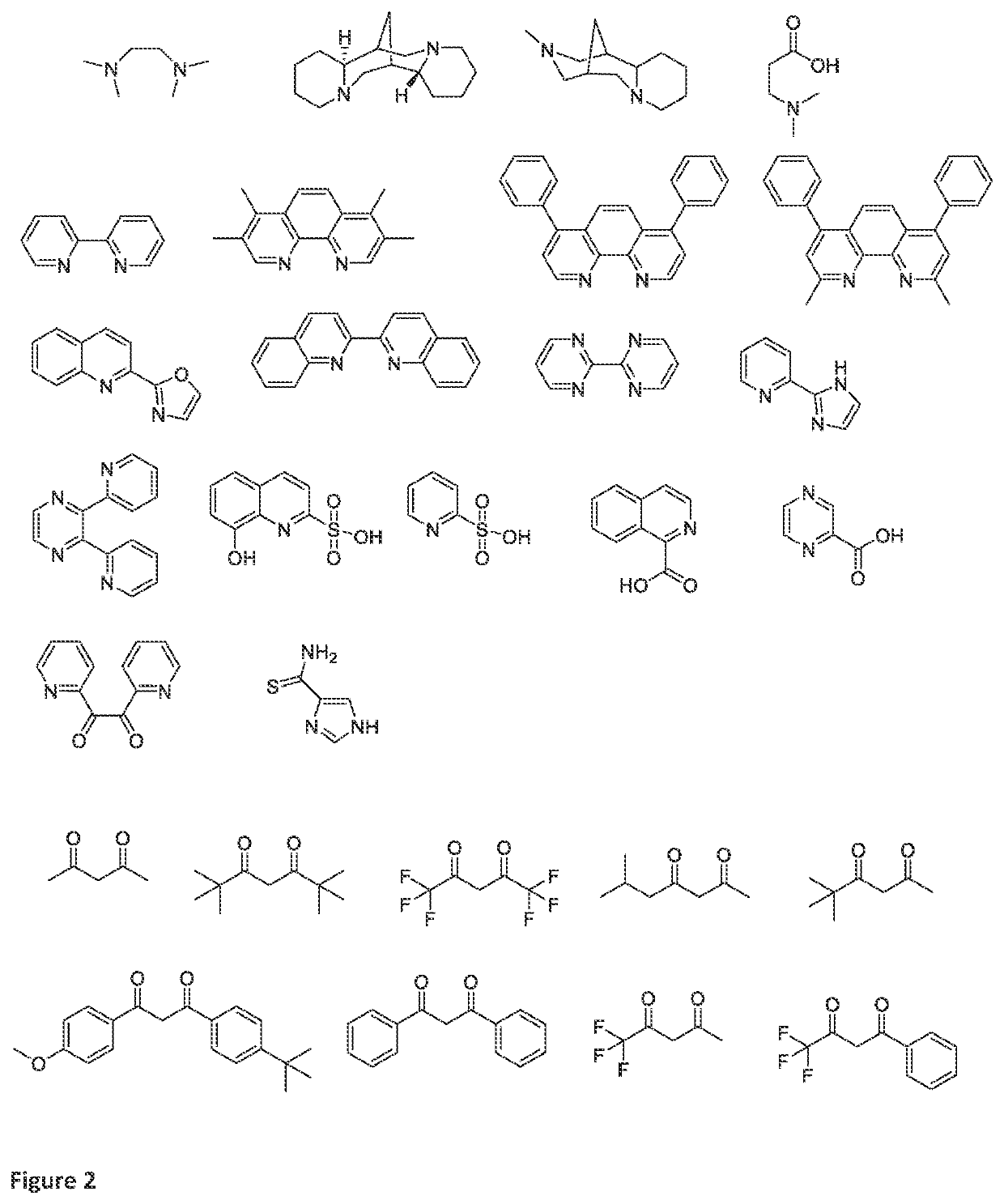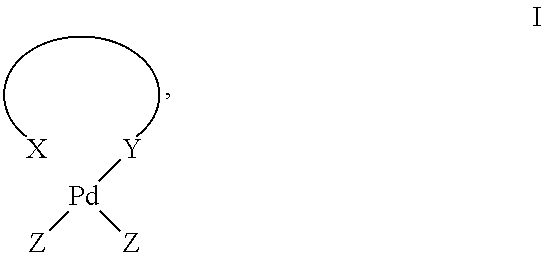Method for preparing unsaturated macrocyclic ketones (II)
- Summary
- Abstract
- Description
- Claims
- Application Information
AI Technical Summary
Benefits of technology
Problems solved by technology
Method used
Image
Examples
examples 1 and 2
, Comparative Examples C1 to C3
DMA / MeCN / H2O=4 / 3 / 1; Pd(NO3)2.2 H2O and Variation of the Co-Catalyst in Pure Oxygen Atmosphere
[0053]A closable 4 ml glass reactor with screw cap and septum was charged with a solvent system consisting of N,N-dimethylacetamide, acetonitrile and water (DMA / MeCN / H2O=4 / 3 / 1; Vtot.=3 ml), and with 1,9-CHDD (isomer mixture; 44 mg; 0.2 mmol). Added to this solution were palladium(II) nitrate dihydrate (0.01 mmol; 5.0 mol %); para-toluenesulfonic acid monohydrate (76 mg; 0.4 mmol) and a co-catalyst (10-20 mol %). The reactor was closed, the septum was pierced with a disposable needle, and the system was brought into an autoclave. The autoclave was purged with oxygen and then the corresponding oxygen pressure was injected (1 bar). Thereafter the reaction mixture was stirred intensely in the autoclave at room temperature for 18 h. The autoclave was subsequently let down and the reaction solution was made up to a constant volume with tetrahydrofuran and homogenized...
examples 3 to 9
DMA / MeCN / H2O; Pd(NO3)2.2 H2O; Fe(NO3)3.9 H2O and Variation of the Solvent Ratio in Pure Oxygen Atmosphere
[0054]A closable 4 ml glass reactor with screw cap and septum was charged with a solvent system consisting of N,N-dimethylacetamide, acetonitrile and water (Vtot.=3 ml), and with 1,9-CHDD (isomer mixture; 44 mg; 0.2 mmol). Added to this solution were palladium(II) nitrate dihydrate (0.01 mmol; 5.0 mol %); para-toluenesulfonic acid monohydrate (38 mg; 0.2 mmol) and iron(III) nitrate nonahydrate (8 mg; 0.02 mmol). The reactor was closed, the septum was pierced with a disposable needle, and the system was brought into an autoclave. The autoclave was purged with oxygen and then the corresponding oxygen pressure was injected (3-5 bar). Thereafter the reaction mixture was stirred intensely in the autoclave at room temperature for 18-20 h. The autoclave was subsequently let down and the reaction solution was made up to a constant volume with tetrahydrofuran and homogenized. The reaction...
examples 10 to 16
DMA / MeCN / H2O=10 / 4 / 1; Pd(NO3)2.2 H2O; Fe(NO3)3.9 H2O and Variation of the Reactant Concentration in Pure Oxygen Atmosphere
[0055]A closable 4 ml glass reactor with screw cap and septum was charged with a solvent system consisting of N,N-dimethylacetamide, acetonitrile and water (DMA / MeCN / H2O=10 / 4 / 1; Vtot.=3 ml), and with 1,9-CHDD (isomer mixture; 0.1-1.0 mmol). Added to this solution were the corresponding amounts of palladium(II) nitrate dihydrate (5.0 mol %); para-toluenesulfonic acid monohydrate (100 mol %) and iron(III) nitrate nonahydrate (10 mol %). The reactor was closed, the septum was pierced with a disposable needle, and the system was brought into an autoclave. The autoclave was purged with oxygen and then the corresponding oxygen pressure was injected (3-5 bar). Thereafter the reaction mixture was stirred intensely in the autoclave at room temperature for 5-20 h. The autoclave was subsequently let down and the reaction solution was made up to a constant volume with tetrahy...
PUM
| Property | Measurement | Unit |
|---|---|---|
| Temperature | aaaaa | aaaaa |
| Temperature | aaaaa | aaaaa |
| Polarity | aaaaa | aaaaa |
Abstract
Description
Claims
Application Information
 Login to View More
Login to View More - R&D
- Intellectual Property
- Life Sciences
- Materials
- Tech Scout
- Unparalleled Data Quality
- Higher Quality Content
- 60% Fewer Hallucinations
Browse by: Latest US Patents, China's latest patents, Technical Efficacy Thesaurus, Application Domain, Technology Topic, Popular Technical Reports.
© 2025 PatSnap. All rights reserved.Legal|Privacy policy|Modern Slavery Act Transparency Statement|Sitemap|About US| Contact US: help@patsnap.com



